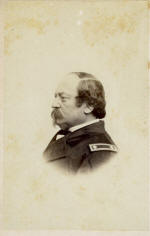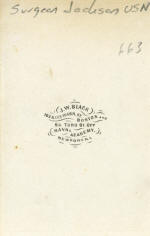Samuel Jackson
Surgeon, Federal U. S. Navy
Samuel
Jackson. M.D., University of Pennsylvania, 1838; surgeon United States Navy, commissioned in 1838 and retired in 1879. with rank of commodore; died at his home in Washington, D. C. July 22, from apoplexy, after an illness of two weeks, aged 88.
Dr. Samuel Jackson, USN
The photographer is J.W. Black of Boston and the Naval Academy at Newport, Rhode Island.
Samuel Jackson was born in Pennsylvania, graduated University of Pennsylvania Medical Department, 1838. Appointed to the Navy from North Carolina June 20 1838 as Assistant Surgeon. Attached to frigate Constitution 1839-41; USS frigate Mississippi 1841-2; frigate Congress Mediterranean Squadron 1842-3; sloop Fairfield frigate Cumberland Mediterranean Squadron 1843-5; razee Independence flag ship Pacific Squadron during Mexican War 1846-9; Navy Yard Philadelphia 1849-50; receiving ship Franklin at Boston 1851; sloop John Adams 1851' sloop Decatur 1851-2.
Commissioned as Surgeon September 2 1852; Rendezvous New York City 1854-5; sloop St Louis coast of Africa 1855-8;
Navy Yard New York 1858-61; steam frigate Wabash 1861; frigate Cumberland 1861; steam sloop Brooklyn 1862-3. While attached to the Cumberland he was present at the bombardment and capture of the Confederate forts at Hatteras Inlet doing service on board the Brooklyn and was with Admiral Farragut in the passage and bombardment of Forts Jackson, St Philip, and the Chalmette batteries below New Orleans. In the destruction of the Confederate Fleet and subsequently in his operations before Vicksburg and Galveston.
Naval Academv at Newport RI 1863-4;. Navy Yard Boston 1864-5-6.
Fleet Surgeon North and South Pacific Squadron on board flag ship Pensacola and Powhatan 1867-9; Naval Hospital Philadelphia 1869; Naval Hospital New York 1869-72; Commissioned as Medical Director March 3 1871; Naval Hospital Norfolk 1873-5; Naval Hospital Chelsea 1875 -9, which completed his service on the active list.
Having attained the age of sixty two 62 years April 1 1879 he was placed on the retired list in accordance with the law of Congress on that subject .
Some of the references to him in the Naval OR’s can be found below.
Report of Lieutenant Sharp, C. S. Navy, giving information obtained while a prisoner on the U. S. ship Congress in Hampton Roads.
BUREAU ORDNANCE,
Richmond, Va., December 9, 1861.
MY DEAR SIR: In a moment of leisure it occurs to me to write you of my observations while on board of the Congress, Commander William Smith, off Newport News, during nine days.
There is a strongly built battery of five large guns riverward, at the upper bridge toward the river. The southeast gun is on a semicircular battery alone; the others on a parapet. The battery seems continuous. <nor6_748>looking inland, but the Congress's deck being about as high as the sand bank, I could not count inland guns, or even see them, though the parapet curvature satisfied me that the battery is circular or oval. The same parallel line of view prevented me from the judging of the number of troops, but it was extensive. The river-edge trees remain; inland, they have been cut down, and houses, etc., are built and being built. In addition to the original old bridge, a fine, large one has been constructed, similar to the ordnance bridge, you may recollect, at Old Point. Steamers go to both bridges. The Express, steamer, runs twice daily between Newport News and Old Point; the other boats are hospital, house boats, etc.
While there one night, about 8 p.m., a steamer was seen and reported as the P. H. [Patrick Henry]. General quarters and thorough preparations were made, but relieved on falsifying the statement. The Congress has removed her gun deck cabin and has two long 32s out of stern ports. The original crew she had in Brazil, Lieutenants J. B. Smith and A. Pendergrast, Purser Buchanan, and Dr. Shippen; all the rest are masters and masters' mates from the merchant service, unless forward officers. At sunset, though always loaded, batteries are primed, guns cast loose and ranged obliquely; regular sea watches kept; no hammocks allowed on gun deck, or lights above water; stream anchor at port quarter, hawsers bent, and others on deck; buoys all around ship, and spars in angular form reach from forward of flying jibbooms, lashed, hung by tackles from head booms and fore channels, passing the last so as to glance off passing objects, torpedoes, etc. Crew well drilled, furnished with Sharps and Miniť rifles, and all modern appliances. Boat howitzer in quarter-deck after ports. Stevens, Butt, and I were confined on the Congress; Dalton and Loyall on the Cumberland, Captain Livingston; officers, Lieutenants G. U. Morris and Selfridge, Dr. Jackson, and others merchantmen appointments. The Cumberland rows guard nightly. Both ships two cables' length apart, under the battery, less than haft a mile distant. The Cumberland has outriggers like the Congress. I left the Congress on the 20th ultimo, when the Cambridge, Commander W. A. Parker, Lieutenant Gwin; Hetzel, Captain H. K. Davenport; Shawsheen, Lieutenant E. R. Colhoun; and another tugboat, armed, were near us permanently. Nightly the small ones distributed themselves above the ship anchorage, keep steam up always, and retire off the battery each morning. The Cambridge is a fore-topsail, schooner-rigged propeller, of 700 or 800 tons, with four or six broadside guns, and one forward and aft; flush hurricane deck. The smaller ones have each a Parrott gun forward and aft. Communications from the Newport News points to Old Point are communicated by flag signals from the terminus of Newport News, doubtless Signal Major Myer's invention. Bright lookouts are always kept up on Pig Point, Sewell Point, Elizabeth River, and all batteries. Not a boat ever escapes observation. As I did not go forward, I did not see what I saw from the Connecticut while passing the Minnesota and Roanoke from seaward. They have grapnels hung from all head booms, spritsail yards, etc., dangling in the water. I suppose ours had, too. The Minnesota has only two lieutenants, Grafton and Watters. Clary commands the propeller Dawn, which has only two Parrott guns in broadside. While on board of the Congress, old Glisson passed a night near us in the Mount Vernon, a vessel similar to the Cambridge.
I asked Captain Hicks to tell you all this, but thought best, later, to write, hoping that the information sent may be advantageous to you. I left Captain Barron well; they are (south) endeavoring to give <nor6_749>exchange for him. I hope they will succeed. I was two and a half months in Fort Columbus, nine days in Fort Warren, one-half day on board the North Carolina, Captain Meade, and nine days on board of the Congress.
Hoping that the contents of this letter may prove agreeable to you, and that you will present my warmest regards to the officers,
I am, sir, with high respect, very truly, yours,
WM. SHARP.
Commander JNO. R. TUCKER,
Commanding Patrick Henry.
Report of Burgeon Jackson, U. S. Navy, of the U. S. S. Brooklyn.
U. S. S. BROOKLYN,
Mississippi River, New Orleans, April 26, 1862.
SIR: I have the honor to report the following casualties, which occurred on board this ship during the brilliant engagement with Forts Jackson and St. Philip, on the Lower Mississippi, and the Confederate batteries, a few miles below the city of New Orleans, on the mornings of the 24th and 25th instant, viz:
Killed, 9.--Mr. John Anderson, midshipman, knocked overboard by a cannon shot; William Lenahan, marine; Daniel McEmory, boy; <nor18_192>Barney Sands, quartermaster; Thomas White, captain main top, head shot off; Henry Roff, marine, head shot off; Andrew Rourke, seaman; Dennis Leafy, ordinary seaman, drowned by being knocked or falling overboard; John Wade, seaman, compound fracture of both bones of forearm, fracture of several ribs, together with internal injuries of chest; died a few hours after the reception of his injuries.
Wounded, 26.--Mr. James O'Kane, master, gunshot wound of left thigh, doing well, not dangerous; Mr. James Stafford, acting master, contused wound of head, slight; Mr. E. S. Lowe, master's mate, contusion, slight; William McBride, ordinary seaman, leg, slight; Lorin Heath, marine, shoulder and neck, not severe; Thomas Griffin, landsman, contusions, arm and hip; John Willoughby, ordinary seaman, left hand shot off, amputation performed above wrist, doing well; John Chase, seaman, leg, slight; Edward [S.] Blanchard, ordinary seaman, shoulder, severe, doing well; J. R. Saunders, marine, contusion of back, slight; William Wells, seaman, eye and leg, severe, doing well; Robert Harrison, ordinary seaman, dislocation of right shoulder and wounds of face; John Hassett, landsman, compound fracture of both bones of left leg; George Coventry, quarter gunner, hand, not severe; Leonard Killion, marine, head, slight; Cornelius Martin, ordinary seaman, wounds of face and lower jaw fractured, very severe, probably mortal; James H. Powell, ordinary seaman, wounds of face, not dangerous; H. P. Bucklin, ordinary seaman, testicles and face, very severe; John Widdis, ordinary seaman, shoulder, slight; John Daverin, landsman, eye and cheek, slight; James Webby, captain mizzen top, gunshot wound of lower jaw, the central portion carried away, and extensive laceration, lips, mouth, etc., very severe, probably mortal; Alex. Anderson, landsman, gunshot wound of foot, doing well; James Buck, quartermaster, contusion of thigh and leg; Joseph Dixon, seaman, flesh wound of arm, slight; John Griffith, captain after guard, knee, slight; James Williams, captain maintop, contusion of knee, slight.
Very respectfully, your obedient servant,
S. JACKSON,
Surgeon.
Captain THOS. T. CRAVEN,
Commanding U. S. S. Brooklyn.

